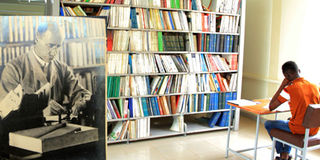Sir Albert Cook library preserving medical history

A student reads in the recently-renovated Sir Albert Cook Library. The library was named after Dr Albert Cook (inset) who established Mengo Hospital. Photo by Rachel Mabala
The works of Sir Albert Ruskin Cook in the Ugandan health sector have been highly documented. Known to many as the father of modern medicine in Uganda, he alongside wife Katherine Cook, established Mengo Hospital in Kampala, which became the first modern health facility in East Africa.
According to writings of Hamu Mukasa, a servant in royal courts at the time, the Briton started working as soon as he set foot in Uganda with his first clinic under a tree.
Seeing between 50-60 patients a day, Cook himself in his writings talks about the effects of chloroform anaesthesia; “With its painless operation and quick recovery, seemed magical to Ugandans —a patient blind from corneal scarring and made to see again by a simple optical iridectomy called me God.”
But Cook was not God, and proof is in the fact that he died.
Today, Cook’s cremented ashes sit in a pot safely placed on shelves housing acid free boxes in Sir Albert Cook Library in Mulago.
Acid-free boxes are common in libraries seeking to safeguard old written and paper material from ageing.
These particular ones at Makerere University’s Sir Albert Cook Library house some patient notes and letters written by the man who did not only establish the library but would later inspire its naming.
Preserving history
Part of any library’s core is to preserve history for generations to come. A visit to Sir Albert Cook Library reveals that the doctor’s notes along-side those of former medical students are still intact.
These particular ones at Makerere University’s Sir Albert Cook Library house some patient notes and letters written by the man who did not only establish the library but would later inspire its naming.
Preserving history
Part of any library’s core is to preserve history for generations to come. A visit to Sir Albert Cook Library reveals that the doctor’s notes alongside those of former medical students are still intact.
The notes are some of the country’s oldest medical records mostly handwritten by some of East Africa’s first medical students in the 1920s and Cook’s patient notes dating back to the late 1890s.
Established in 1924, the library plays a big role for medical students, researchers, health workers and the general public looking for information about medicine or its history.
According to Prof Charles Ibingira, the principal of Makerere University College of Health Sciences, the library is a hub of information for re-search, learning and teaching. However, due to limited funds, the facility, like many public structures, had lost its face and was in a dilapidated state forcing its intended users to abandon it.
“Many students thought it was old and outdated thus preferred to go to other libraries or their hostels than coming here,” says Dr Alison Annet Kinengyere, the college librarian.
Getting facelift
Last week at the college, Stanbic Bank handed over the Sir Albert Cook Library to the Makerere University Management after renovations worth Shs197m. This is after the management had the facility closed for nearly a full semester to allow the bank give the building a facelift that saw it expand to include research carrels.
In his speech, Prof Ibingira said despite the fact that the library is one of the oldest and biggest medical libraries in the region, its last renovations had been in 1968.
And without adequate restocking, the repository library was mostly depending on different students’ PHD masters’ thesis for new material. “The book bank in all departments is almost finished —we have not received a single book or budget from the main campus for years,” Ibingira noted.
He said though that in a digital era, they are looking at following the trends by digitising the library. “We are looking at acquiring as many electronic books as possible and then all the students will need stable internet connection.”
Kinengyere notes that efforts to even digitise some of the older works is already under way, as works like Dr Cook’s written paper notes are in the process of being preserved in a soft form.
“So far we have already digitised 304 documents from Cook’s rare collection,” she says.
Much as the library is open to the public, it has its reservations. For instance, it is free to students of Makerere University and all Ugandan medical workers, but outsiders have to part with Shs20,000 per month to access the information.
Once the digitising process is done, the electronic database will be expected to replace the print version. The digital version of the books will be accessible to students through an online database.
About public libraries
Currently, the National Library of Uganda works with a network of 46 public libraries and more than 100 community libraries spread countrywide. Of the 46 public libraries, 17 have electricity, only 11 of them have professional librarians managing them and 14 of them have computers.
Book Aid International in partnership with the National Library of Uganda has established fully fledged children’s libraries in 22 of the public libraries so far.
At the local governments, public libraries are under the departments of community development and Education. The government of Uganda supports the libraries with a small grant for the development of the library service.
Report on the status of public libraries in Uganda - 2017




